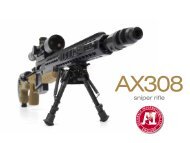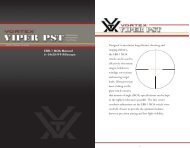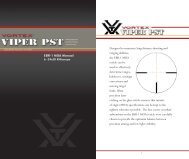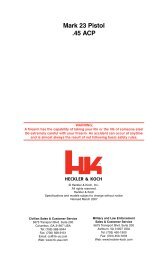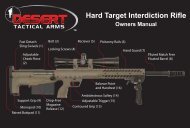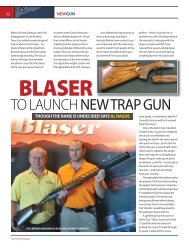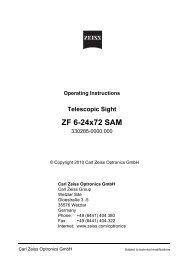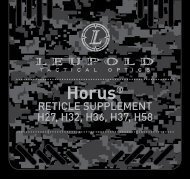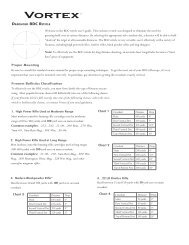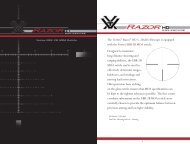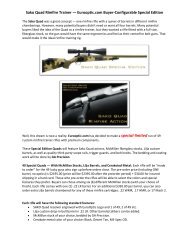Barrett M107A1 Manual
Barrett M107A1 Manual
Barrett M107A1 Manual
You also want an ePaper? Increase the reach of your titles
YUMPU automatically turns print PDFs into web optimized ePapers that Google loves.
Eye protectionEye protection should be worn when both shooting and maintaining your rifle. It isnormal for firing to generate airborne dust and debris. Glasses also protect you fromscopes during recoil. Protect your eyes from solvents and uncaptured parts underspring pressure while performing maintenance on your rifle.Assume every gun is loadedTreat every gun as if it were loaded. Do not trust your memory and do not take anyoneelse’s word for it. Visually look and physically feel for an empty chamber. Do not trustthe extractor to provide an empty chamber.Beware of barrel obstructionsEnsure the barrel’s bore is free of obstructions before you fire your rifle. Even thesmallest obstruction such as a stuck patch or even grease will cause dangerouslyincreased pressures that can rupture the barrel.Use your muzzle brakeYour rifle was designed to be fired with the muzzle brake installed. Firing your riflewithout the muzzle brake will subject your rifle and its accessories to damaging recoil. Itcould also cause the shooter to be injured.Muzzle controlAlways keep the muzzle pointed in a safe direction. Never allow your muzzle to point atanything that you do not intend to shoot.Keep your finger off the triggerKeep your finger off the trigger and out of the trigger guard until your sights are alignedon your target and you intend to fire.Keep your safety onKeep your safety on until your sights are aligned on your target and you intend to fire.2
Identify your target and backstopBefore you pull the trigger, make certain of your target and what is beyond it. The rifleshould never be fired at surfaces where bullets are likely to glance off in unpredictabledirections.Failure to fireIf your rifle fails to fire when you pull the trigger, do not attempt to clear the action. Keepthe rifle pointed toward a safe area and wait two minutes. If a hang fire (slow ignition)has occurred, the round will probably fire within two minutes. If the round does not fire,remove and inspect the cartridge. If the primer is indented properly, discard it in a safemanner. If the primer is lightly dented, refer to the troubleshooting chart in this manual.Maintain your rifle properlyPerforming proper maintenance, as outlined in this manual, insures that your rifle will besafe to shoot and will perform to design specification for many years. Alterations,modifications or adjustments may damage your rifle, make it unsafe to fire and will voidwarranty claims.Store your rifle safelyEven though your rifle represents a significant financial investment, the greatest value inkeeping it secured is preventing it from falling into the hands of a child, a careless adult,or a thief. It is your responsibility to take every reasonable precaution to secure yourrifle.Alcohol, medications and drugsDo not handle or operate your rifle under the influence of alcohol, medication or drugs.3
WARRANTY AND SERVICE<strong>Barrett</strong> Firearms Manufacturing, Inc. (BFMI), warrants that this firearm wasmanufactured free of defects in materials and workmanship. For one year from the dateof purchase by the original owner, BFMI agrees to correct any defect in this firearm forthe original purchaser by repair or replacement with the same or comparable model.BFMI will not be responsible for injury, death, or damage to property resulting fromeither intentional or accidental discharge of this firearm or from its function when usedfor purposes or subjected to treatment for which it was not designed. BFMI will nothonor claims involving this firearm which result from careless or improper handling,unauthorized adjustment or parts replacement, corrosion, neglect, the use of the wrongcaliber ammunition, or the use of other than commercially manufactured ammunition ingood condition, or any combination thereof. BFMI will not honor claims involving thisfirearm when such claims are made by the second or subsequent owner.If you need factory service, whether made under warranty or not, please contact BFMIfor a Return Authorization Number and instructions on how to have your gun repaired.<strong>Barrett</strong> Firearms Manufacturing Inc.P.O. Box 1077Murfreesboro, TN 37133-1077615-896-2938mail@barrett.netwww.barrett.netLIMITATION OF LIABILITYThe liability of <strong>Barrett</strong> Firearms Manufacturing, Inc. for any and all losses and damagesto the purchase shall in no event exceed the purchase price of the firearm, and thenonly if the firearm is proven to be defective in material or workmanship. <strong>Barrett</strong>Firearms Manufacturing, Inc. shall under no circumstances be liable for incidental orconsequential damages resulting from negligence of <strong>Barrett</strong> Firearms ManufacturingInc. or from negligence or misuse of the purchaser.<strong>Barrett</strong> Firearms Manufacturing, Inc. makes no other warranties of any kind, expressedor implied with respect to the <strong>M107A1</strong>.Your ResponsibilityYour <strong>Barrett</strong> rifle is well-engineered and manufactured to the highest standards. It wasproof-fired and carefully inspected before it was packaged and shipped from our factory.Its safe use depends on you alone. You are the ultimate safety device. Much like othermechanical devices, such as electric power tools, gas-powered lawn equipment, andautomobiles, your rifle is safe unless handled in an irresponsible or uneducated manner.4
TABLE OF CONTENTSUse of the <strong>Manual</strong> 1Safety Guidelines 1-3Warranty and Service 4Table of Contents 5Specifications & Capabilities 6Contents 7General Function, Storage, Repair 8Break-in 8Equipment Description & Data 9-10Inspection of Major Components 11Upper Receiver 12Bolt Carrier Group 13Lower Receiver 14Assembly of Major Components 15-19Operating the Rifle 20-23Suppressor 24-25Preventative Maintenance Procedures 26Cleaning and Lubrication 27Exploded Views and Parts Lists 28-29Troubleshooting 30-325
SPECIFICATIONSModel: <strong>M107A1</strong> <strong>M107A1</strong> CQCaliber: .50 BMG (12.7 x 99 mm) .50 BMG (12.7 x 99 mm)Operation: Semi-Automatic Semi-AutomaticWeight: 28.55 lbs (12.95 kg) 27.25 lbs (12.36 kg)Overall Length: 56.8" (144.28 cm) 48.4" (122.94 cm)(Assembled)Length: 37.75" Lower 37.75" Lower(Takedown Mode) 41.375" Upper 41.375” UpperBarrel Length: 29" (73.66 cm) 20.6" (52.32 cm)Barrel Twist: 1:15 1:15Magazine Capacity: 10 rounds 10 roundsStock:Integral with Lower receiver Integral with Lower receiver– steel– steelSafety: <strong>Manual</strong> thumb-lever <strong>Manual</strong> thumb-leverSights:Fixed front, Adjustable rearsightsFixed front, Adjustable rearsightsCAPABILITIESMuzzle Velocity:<strong>M107A1</strong> .50 BMG-Approximately 2750 f/s (853 m/s) withstandard 660 grains (42.8 g) projectile<strong>M107A1</strong> CQ .50 BMG – Approximately 2500 f/s (762 m/s) withstandard 660 grains (42.8 g) projectileMaximum Range:Approximately 8,046 meters6
CONTENTSYour <strong>M107A1</strong> rifle includes the following:RifleWatertight and airtight carrying caseOperator’s manual1 MagazineYour rifle may have included a monopod, bipod, suppressor, rifle scope, BORS, rings orother optional accessories. It may have also included cleaning fluids and a cleaning kit.The rifle is shipped from the factory in 2 pieces; the upper receiver assembly and lowerreceiver assembly.7
TYPE OF MANUAL: Operator’s instruction manual for the <strong>Barrett</strong> <strong>M107A1</strong> rifle.GENERAL FUNCTIONAs the cartridge is fired, the energy from the projectile drives the barrel rearward. Therearward moving barrel drives the bolt carrier rearward. As the bolt carrier moves to therear, the bolt unlocks and the cartridge is extracted and ejected from the rifle. Near theend of the bolt carrier’s rearward motion, the bolt us fully extended, the rifle is cockedand the main spring buffer is compressed. As the bolt carrier starts its forward motion, itfeeds a new cartridge into the chamber and locks into battery position ready to fireagain.PREPARATION FOR STORAGE OR SHIPMENTThe <strong>M107A1</strong> should always be stored and transported in its airtight, watertight carryingcase where possible.RIFLE REPAIRRifle repair will be accomplished by <strong>Barrett</strong> Firearms Manufacturing, Inc. In the eventthe <strong>M107A1</strong> requires repair, it is to be sent as a complete assembly, packaged asdescribed above.BREAK-IN PROCEDUREBecause individual barrels, powder, primer and bullet combinations vary widely andbecause shooters have strongly held personal opinions on the subject, <strong>Barrett</strong> does notoffer a specific procedure for barrel break-in. <strong>Barrett</strong> recommends that you do notoverheat your barrel, especially your new barrel. Experience has shown that the borebecomes less prone to fouling over time and that accuracy may increase as this occurs.8
EQUIPMENT DESCRIPTION AND DATAEquipment Specifications and Capabilities. The technical specifications andcapabilities of the <strong>M107A1</strong> (Figure 1-1).Figure 1-1. Rifle, <strong>M107A1</strong>IDENTIFICATION AND DESCRIPTION OF MAJOR COMPONENTS1. Upper Receiver. Aluminum extrusion cover combining and including the frontand rear sights, integrated scope rail, cheek piece, muzzle brake and barrel.2. Rear Sight Leaf. Peep style aperture with elevation markings for 100 to 1500meters. Rear sight scale for .50 BMG.3. Front Sight. Flip up from inside the rail.9
4. Muzzle Brake. Critical for recoil absorption. Cylindrical design for SoundSuppressor integration.5. Barrel. Muzzle end is threaded to accept cylindrical muzzle brake; breech endhas a barrel extension integral to the locking function.6. Bolt. Lightweight and Nickel Teflon coated. Houses the extractor and ejector.7. Bolt Carrier. Consists of the bolt (8), firing mechanisms, cocking lever, andsear.8. Bipod Assembly. Forward support system comprised of lightweight Titaniumretractable bipod legs and Polymer extending feet. Bipod assembly is quickdetachablefrom the receiver.9. Lower Receiver. Sheet metal cover combining and including the bipodassembly, buffer, midlock pin, and trigger mechanism.10
INSPECTION OF MAJOR COMPONENTSWARNINGUnload and clear the rifle before disassembly.Ensure no live ammunition is present during disassembly or assembly.Inspection of Rifle’s Major ComponentsThe rifle’s four major groups are packaged as shown in below.1. Upper Receiver2. Bolt Carrier Group3. Lower ReceiverEnsure all components are present and inspect for obvious damage, reporting anydiscrepancies to the <strong>Barrett</strong> factory. Detailed inspection should be conducted asfollows:11
INSPECTION - THE UPPER RECEIVER1. Barrel springs must not be overstretched, and each coil should be tight, with nospaces between coils.2. Battery bumpers should be in good condition (not frayed, cracked, or twisted).3. The muzzle brake should be tight and fully screwed on.4. The upper receiver should not be cracked, bent, or burred.5. Check the hinge lip at the front of the upper receiver to ensure that it is notcracked, bent, or deformed in any way.6. The barrel should be clean and free of obstruction.7. All scope mountings should be tight, in good condition, and free of oil (iron sights,front and rear, may be lightly oiled at pivot points to prevent corrosion).12
INSPECTION - THE BOLT CARRIER GROUP1. Ejector (1) and extractor (2) must be checked to ensure they are under springtension, and neither chipped nor worn. Extractor and Ejector should not stick inone position.2. With firing mechanism de-cocked (use rear lock pin to depress sear (3)),manually work the bolt (4) in and out, feeling for any roughness, which mayindicate wear, corrosion, or dirt/grit in the bolt carrier (5).3. Push the bolt into the carrier and inspect the firing pin to ensure it is protrudingthe bolt face. Check firing-pin hole (on bolt face) to ensure it is not eroded orelongated. Bolt face should not be pitted.4. Swing the cocking lever (6) forward. The sear (3) should capture the firing-pinextension (7) before the cocking lever is fully depressed.5. <strong>Manual</strong> Bolt Extender (8) slot should be free and clear of debris13
INSPECTION - THE LOWER RECEIVER1. With bolt carrier in place, pull it rearward and check to see that the mainspringmoves freely (full travel) and is not deformed.2. Hold bolt carrier back while clearing the mainspring housing (sheet metal closure).With the thumb safety on fire, pull the trigger. Firing mechanism should function (aslight rise in bolt carrier is normal). If the housing is bent, the bolt carrier will riseexcessively as the trigger is pulled, preventing proper functioning.3. Lower receiver should not be cracked, bent, or burred.4. Check the hinge pin at the front of the lower receiver to ensure that it is not cracked,bent, or deformed in any way.5. Check bipod assembly for function and ensure the mounting hardware is tight.14
ASSEMBLY OF MAJOR COMPONENTS1. Grasp the Lower Receiver Group and extend the bipod legs by pulling the legsdown to the front, where they will lock into place. To retract, pull down on leg andswing back into position along the receiver. If firing without using the bipod, foldthem forward to preclude interference with the charging handle. Pulling on thefeet of the bipod causes the legs to extend. To retract a leg, depress the plungerlocated on the bipod leg and push up on the foot. Place receiver on levelsurface.2. The Bolt Carrier Group is held in place under tension in the lower receiver by themidlock pin, which extends through a locking hole in the receiver’s sheet metal.(Both the midlock pin and the rear lock pin, located in a retaining hole in the endof the buttstock, have finger rings to aid in removal.)15
3. Standing above and to the rear of the lower receiver, grasp the charging handlewith the right hand, and carefully pull back, against tension, while withdrawing themidlock pin from its retaining hole. Allow the bolt carrier to come forwardSLOWLY until there is no more spring tension and it rests in the lower receiver.4. Carefully pick up the upper receiver. The barrel will be nested inside for compactstorage. Align the barrel so that its feed-ramp (slanted entry to firing chamber) isto the bottom. Keeping fingers away from the barrel hold the upper receiverhorizontally in the direction of the muzzle. The barrel should fall into place at itsfull forward extension in the receiver. Slide the impact bumper into position onthe large diameter of the barrel and against the barrel stop.16
WARNINGTHE TENSION ON THE BARREL SPRINGS IS ABOUT 70 lbs (32 kg). SERIOUSINJURY COULD RESULT IF SPRINGS ARE SUDDENLY RELEASED.5. The barrel springs at the front of the upper receiver are held together by thebarrel key. Maintaining the downward tilt of the upper receiver (to keep the barrelin place) firmly grasp the barrel key—not the springs—and pull it into place onthe forward slot of the barrel. Work the barrel key until it is firmly seated in thebarrel slot. The upper receiver is now fully assembled.6. Position the upper receiver rear up, muzzle down, over the lower receiver.CAUTIONBE SURE THE UPPER RECEIVER NOTCH AND LOWER RECIEVER HINGE PINARE PROPERLY MATED, OR THE RIFLE CAN BE DAMAGED BY FINALASSEMBLY MOTION.17
7. Engage the notch in the front barrel bushing of the upper receiver with the fronthinge pin of the lower receiver. While positioned directly behind the rifle, graspthe charging handle and pull rearward against mainspring tension so the bolt willclear the barrel extension when the upper receiver is lowered.8. Lower and close the upper receiver onto the lower receiver. Release thecharging handle SLOWLY until the bolt is fully closed.WARNINGTHE RIFLE MUST NOT BE FIRED WITHOUT BOTH THE MIDLOCK AND REARLOCK PINS FIRMLY IN PLACE. SERIOUS INJURY OR DEATH COULD RESULT.18
9. Place the midlock pin (shorter pin) through the hole near center bottom of therifle, until it snaps fully to lock the upper and lower receivers together. Insert therear lock pin through the rear hole of the upper receiver to complete the mating ofthe receivers.Inspection of the ActionWARNINGTHERE SHOULD BE NO AMMUNITION PRESENT DURING THIS TEST.1. Grasp the charging handle and dry-cycle the rifle several times (work the bolt allthe way back and forth). This will serve two purposes. First, if there has beenany damage to the sheet metal housing during shipping, the bolt carrier will notmove freely. Second, the shooter will be able to determine if the bolt fully closesand rotates to a locked position.19
OPERATING THE RIFLELoading the MagazineUsing appropriate ammunition, load the magazine in the normal manner. Ensure thatcartridges are pushed all the way to the rear of the magazine. Load no more than 10rounds.SafetyThere is a single thumb-lever that prohibits the trigger from being pulled. Position thelever pointed towards SAFE.20
Inserting Magazine1. Insert the magazine into the magazine well in the lower receiver, with magazinetilted at approximately a 45° angle (bullet tips upward). Insert the front of themagazine hook to its hinge, located in the front of the magazine well.2. Swing the rear of the magazine up until it locks into place by means of themagazine catch. It should lock in with an audible click. Be aware that it ispossible to insert the hook on the front of the magazine incorrectly. Pull down onthe magazine to verify that it is properly seated.Charging the RifleWARNINGDO NOT ATTEMPT TO FORCE A CARTRIDGE INTO THE CHAMBER BY FORCINGTHE BOLT CLOSED. IF THE BOLT WILL NOT CLOSE EASILY, REMOVE THECARTRIDGE AND EXAMINE IT FOR DAMAGE OR DEFECTS. CHECK THECHAMBER FOR OBSTRUCTIONS.1. With the safety in the safe position (safety lever horizontal) and the muzzlepointed in safe direction pull the charging handle to the rear until it stops, thenrelease it (do not keep your hand on the changing handle). The rifle then loadsand locks under its own spring power for all subsequent rounds.21
Firing the RifleWARNINGDOUBLE HEARING PROTECTION SHOULD BE WORN WHEN FIRING SINCEHARMFUL LEVELS OF NOISE ARE GENERATED.WARNINGTHE SHOOTER MUST BE POSITIONED DIRECTLY BEHIND THE RIFLE WITH THERECOIL PAD HELD FIRMLY AGAINST THE SHOULDER. FIRING THE RIFLE INANY OTHER POSITION COULD RESULT IN INJURY BY CONTACT WITH THERIFLE OR RIFLE SCOPE.1. Because the rifle is recoil-operated, the shooter must be positioned squarelybehind the rifle, with the recoil pad firmly against the shoulder. Anything lessmay result in injury, discomfort, or failure of the action to cycle correctly.2. Position the safety (lever vertical) pointed towards FIRE.3. The rifle may now be fired. The rifle will fire one round for each squeeze of thetrigger until the magazine and chamber are empty.22
WARNINGTHE BOLT DOES NOT AUTOMATICALLY REMAIN TO THE REAR WHEN THERIFLE OR MAGAZINE IS EMPTY WHICH CAN CAUSE INJURY OR DEATHFROM AN UNINTENTIONAL DISCHARGE.4. After the magazine is emptied, or you are done firing, use the selector to placerifle in “SAFE” position and remove magazine. Pull and hold the charging handleto the rear while visually and physically checking for an EMPTY chamber. Onceyou have ensured the chamber and magazine wells are empty, release thecharging handle to allow the bolt to close.Unloading Rifle1. Place the rifle in the “SAFE” position (safety lever horizontal).2. Press the magazine catch forward, towards the magazine and remove themagazine.3. Pull the charging handle to the rear to eject any cartridge still chambered. (Onemethod of indicating the rifle has been cleared is to take an empty cartridge case,insert it halfway into the ejection port so that the neck is visible, and ease the boltforward onto it.)CAUTIONDO NOT LEAVE ROUNDS IN THE MAGAZINE FOR EXTENDED PERIODS OFTIME SINCE THIS WILL CAUSE THE SPRING TO LOSE TENSION AND MAYCAUSE A MALFUNCTION.Unloading the Magazine1. Hold the magazine in either the right or left hand, cartridges facing away fromyou.2. Using the thumb of the other hand, push the cartridges out one after another,until all are ejected.23
SUPPRESSORYour <strong>Barrett</strong> <strong>M107A1</strong> Rifle System may include a <strong>Barrett</strong> Sound Suppressor.Auxiliary Muzzle BrakeThe <strong>Barrett</strong> suppressor system comes with a detachable auxiliary muzzle brake. Thesuppressor functions with or without this brake, depending on your preference. Thebrake will alleviate some recoil, but the most sound and flash suppression isaccomplished without the brake.1. To install the auxiliary muzzle brake, you will need T-25 Torx Wrench.2. Clean the face of the suppressor and place the auxiliary muzzle brake on thefront, aligning the bores.3. Install and torque the 4 T-25 Torx Screws to 20 in/lbs.24
Suppressor Installation1. To install the suppressor, slide the coupling opening over the cylindrical muzzlebrake, making sure the tabs clear the slots and the latch is in the “UNLOCK”position.2. An indexing pin inside the suppressor locates on the rifle’s muzzle brake,ensuring proper alignment.3. Tighten the suppressor lock ring by hand, engaging the notches with the latchand ensuring a secure fit. NOTE: It is very important that this ring be tightlysecured to keep the suppressor in place.4. To detach the suppressor, press the suppressor latch and turn the lock ringcounter clockwise until notches are disengage and latch is in the “UNLOCK”position. Slide the suppressor off the rifle’s muzzle brake.25
PREVENTIVE MAINTENANCE PROCEDURESGeneral Maintenance1. Ensure that all bearing surfaces and exposed parts, particularly those listedbelow, are clean and lightly coated with a CLP (cleaner, lubricant, preservative)Oil.a. Barrelb. Bolt and bolt carrierc. Mainspring housingd. Trigger assemblye. Transfer bar assemblyf. Lower Receiver2. Inspect all parts for fit and tighten or replace, as necessary.a. Inspect all parts (especially along welds) for cracks or damage andreplace, if necessary.b. Each time the rifle is assembled for firing ensure that the barrel, chamber,and locking lugs of the bolt are free of excess oil. When possible, anoperational check using ten dummy rounds should be performed. Insertthe dummy rounds into a magazine and load the magazine into the rifle.<strong>Manual</strong>ly cycle the bolt carrier group making sure the cartridges feed,extract, and eject properly.c. Refer to the Troubleshooting section of this manual.26
CLEANING AND LUBRICATIONWARNINGUNLOAD AND CLEAR THE RIFLE BEFORE CLEANING.CAUTIONDO NOT INSERT CLEANING RODS THROUGH THE MUZZLE. THE BARRELCROWN COULD BE DAMAGED WHICH WOULD SEVERELY DEGRADE THEACCURACY OF THE RIFLE.CAUTIONTO PROTECT THE RIFLE FROM CORROSION, THE RIFLE AND THE INTERIOROF THE CARRYING CASE SHOULD BE MOISTURE FREE BEFORE THE RIFLE ISPLACED IN THE CARRYING CASE FOR STORAGE.Cleaning Procedure1. The rifle should be cleaned and lubricated after each shooting session. Regularcleaning prevents the corrosive effects of moisture.2. Apply cleaning solvent to a chamber brush and clean the chamber. <strong>Barrett</strong>Heavy Bore Cleaner is recommended.3. Apply cleaning solvent to a bore brush and clean the bore. <strong>Barrett</strong> Heavy BoreCleaner is recommended.4. Clean the muzzle brake with a stiff plastic brush and bore solvent. It is best toclean the muzzle brake at the same time the barrel is being cleaned as the boresolvent will help loosen the carbon build-up on its interior walls.5. Clean the bolt face with bore solvent. Use a stiff plastic brush to remove carbonfrom both the extractor and the ejector. Depress the ejector and extractor byhand to test their smooth function.6. As soon as cleaning is finished, use dry patches as necessary to remove solventfrom all cleaned surfaces.7. Clean the remainder of the rifle with cotton-tipped swabs, general-purposebrushes and rags. Make sure all metal surfaces are coated with preservative oil.27
<strong>M107A1</strong> RIFLE28
TROUBLESHOOTINGMalfunction Inspect and Test Corrective Action1. Failure to feed 1. Sluggish action Clean and lubricate or (if cold) remove excesslubrication2. Check to see if themainspring buffer isdraggingReplace the buffer if the head diameter is over1.850 in. Replace the buffer if showingexcessive/uneven wear3. Check Magazinea. Proper installation a. Reinstall magazine into the receiverb. Dirt/debris b. Clean magazinec. Damage c. Replace magazine4. Rifle short cycles Hold rifle more firmly in the shoulder5. Bolt carrier assemblybinds6. Weak/brokenmainspringPlease contact tech supportReplace mainspring2. Failure tochamber1. Check cartridge fordamageRemove damaged round2. Check for dirty chamber Clear and clean chamber3. Check for faultymainspringReplace mainspring4. Check for bent receiver Please contact Tech Support3. Failure to cock 1. Check bolt carrier forproper assembly, worn ormissing partsa. Replace worn or damaged partsb. Reassemble correctly30
Malfunction Inspect and Test Corrective Action4. Failure to lockor unlock1. Check for obstructionbetween firing pin and bolt2. Check for excessive dirtor debris in locking areaDisassemble and cleanClean chamber and barrel extension4. Check bolt spring fordamage and properinstallation5. Check for broken orburred bolt latch or boltlatch springReplace or reinstall bolt springPlease contact Tech Support5. Failure to fire 1. Faulty ammunition Replace ammunition2. Verify bolt carrier is fullyin battery<strong>Manual</strong>ly cycle carrier (do not force carrierclosed)3. Check for improperinstallation of firing pinAssemble properly4. Check for broken orimproper installation oftrigger componentsHave a <strong>Barrett</strong> Certified Armorer replace orreinstall trigger components5. Check for obstruction ofthe firing pin or triggerRemove obstruction or debris6. Failure toextract1. Check for broken ormissing extractorHave a <strong>Barrett</strong> Certified Armorer replaceextractor2. Ensure extractor ismoving freely in slotHave a <strong>Barrett</strong> Certified Armorer remove, cleanand lubricate extractor, plunger, and spring3. Check for dirty chamber Clean chamber31
Malfunction Inspect and Test Corrective Action7. Failure to eject Check for propermovement of ejectorHave a <strong>Barrett</strong> Certified Armorer remove,clean, lubricate or replace ejector and/or springas needed8. Very hard recoil 1. Check for faulty/hotammunitionReplace or cool ammunition2. Check for damaged ormissing mainspring/bufferReplace/install mainspring or buffer as needed3. Check for loose,missing,damaged/clogged muzzlebrakePlease contact Tech Support32
P/N 12927 5/18/201133



